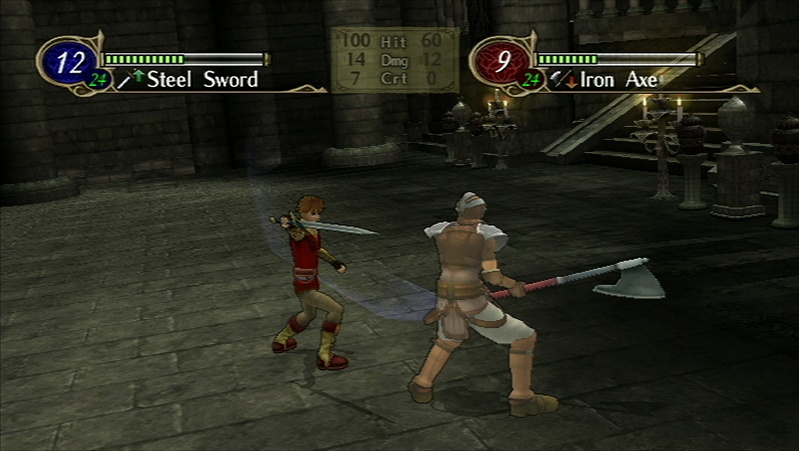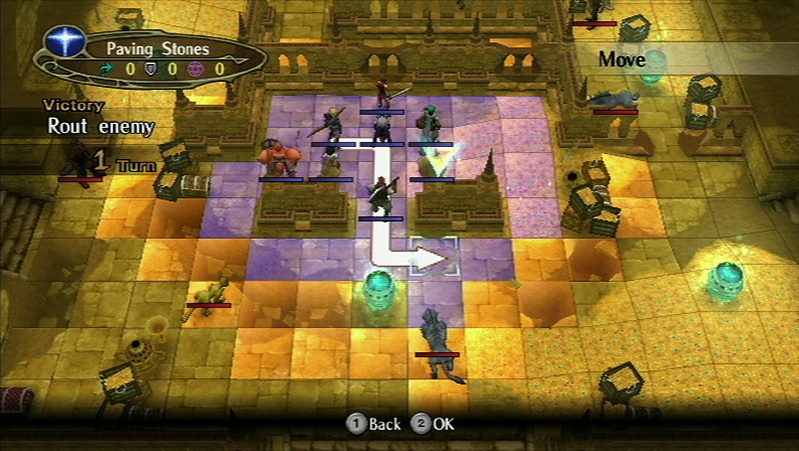Fire Emblem: Radiant Dawn Hands-On
We spend a few hours with a near-finished version of this promising turn-based strategy game.
Fire Emblem: Radiant Dawn's North American release date is now less than a month away, but this week marks the first opportunity that we've had to spend some time with an English-language version of the game. The differences between the North American game and the Japanese version that we played previously are minimal, but the addition of 16:9 support is certainly a bonus for those of us with the necessary hardware to play games in widescreen. Given that the Fire Emblem games are known for their strong character-driven narratives, playing the English-language version of Radiant Dawn has let us get a much better feel for the story than we had previously. We've also put to good use a number of new features that we didn't know existed until now.
When you start a new game of Fire Emblem: Radiant Dawn, you'll be able to choose from three difficulty settings, though the hardest of them will be locked the first time you play. That might be disappointing for those of you who have beaten previous games in the long-running series, but having spent some time playing on the middle difficulty setting, we can report that it offers a reasonable challenge. If you're a fan of the series, then you might recognize some of Radiant Dawn's protagonists, such as the rogue Sothe, who is undoubtedly one of the most powerful characters in your party early on. You'll also recognize the vast majority of Radiant Dawn's gameplay features, although there are definitely a handful of older ones returning, and some all-new features in the mix.

For those of you who aren't familiar with this particular turn-based strategy series, Fire Emblem distinguishes itself from the competition with a number of key features. Perhaps the most obvious of these is the fact that once a member of your party dies in the game, that's it; they're dead. If the character in question was story-critical then you'll unceremoniously be presented with a "game over" screen. If his or her presence isn't strictly necessary for the story to progress, then you have the option to just continue onward, which can be a difficult decision if you've invested a lot of time into that character's development or simply happen to like his or her particular brand of damage-dealing. In previous Fire Emblem games, the idea of replaying entire levels in an attempt to save a character's life could be a daunting prospect, but Radiant Dawn introduces a "battle save" option that lets you save your progress at any point during a battle. This has the side effect of making the game significantly easier if you choose to use it a lot, but it certainly beats having to play through the early stages of any given battle repeatedly.
Another feature of the Fire Emblem games that's worthy of a mention is the fact that characters who are being attacked don't simply stand there and take whatever they've got coming to them. Your party members and enemies alike will often manage to evade incoming attacks and, more often than not, will retaliate with powerful attacks of their own. It's not a groundbreaking feature by any means, but it adds an extra layer of strategy to the proceedings because, by positioning one of your stronger characters in a spot where enemies are more likely to attack him or her than any of your other characters, you might be able to wipe out a significant portion of the enemy force when it's not even your turn. With that said, your enemies in Fire Emblem: Radiant Dawn aren't stupid, and they'll seize any opportunity you give them to attack the weaker members of your party. Priests and archers are certainly favorite targets, though any class that's relatively bad at defending itself will almost always be attacked ahead of your more traditional fighting classes.
The last distinguishing feature of the Fire Emblem games that we'll mention on this occasion is the way that character development is handled. Every character is rated in eight attributes, such as health points, skill, magic, and luck. When a character levels up, some of those attributes will improve, but how many of them and which ones get the boost is completely random. Because of this, no two games of Fire Emblem: Radiant Dawn will ever be quite the same, and a character who is nigh-on unstoppable for you might be a waste of space in a friend's party. You'll have the opportunity to influence character progression somewhat by allocating "bonus experience points" in-between missions, but even then you won't get to choose which attributes get boosted.

Although we've played through only a handful of Fire Emblem: Radiant Dawn's missions at the time of writing, there has been no shortage of variety. We've been tasked with wiping out enemy forces, escaping from levels by reaching an exit, escorting defenseless characters to safety, and defending a small group of friendly characters facing an overwhelming enemy force for a number of turns, for example. Furthermore, there are invariably multiple ways to approach each level in the game, and once your party size exceeds the number of characters that you can play with simultaneously, the outcome of the battle will often be dictated by who you choose to take to the battlefield. Interestingly, you'll quite frequently have opportunities to add to your party by meeting certain criteria and convincing enemies to join you. For example, on one of the missions we played, we were able to convince a soldier to join our group simply by having a specific member of our party talk to him. How did we know that it would work? We didn't. But in the story sequence preceding the mission, we learned that a friendly soldier had offered some assistance to our party, and on the battlefield this particular soldier was labeled with his name rather than just his class.
During gameplay you'll get to check out nicely animated close-ups of characters doing battle with one another, but because many of the game's cutscenes are conversation-based, there's very little animation to speak of. Regardless, Fire Emblem: Radiant Dawn's visuals are easy on the eyes, even if they don't massively improve upon 2005's GameCube offering, Fire Emblem: Path of Radiance.
We're enjoying every minute of Fire Emblem: Radiant Dawn after a few hours of play, and, frankly, we're eager to get back to it and what the plot has in store for our party next. Fire Emblem: Radiant Dawn is currently scheduled for release in North America on November 5, though tragically no European or PAL release has been confirmed at the time of writing. We look forward to bringing you more information on this one as soon as it becomes available.
Got a news tip or want to contact us directly? Email news@gamespot.com
Join the conversation